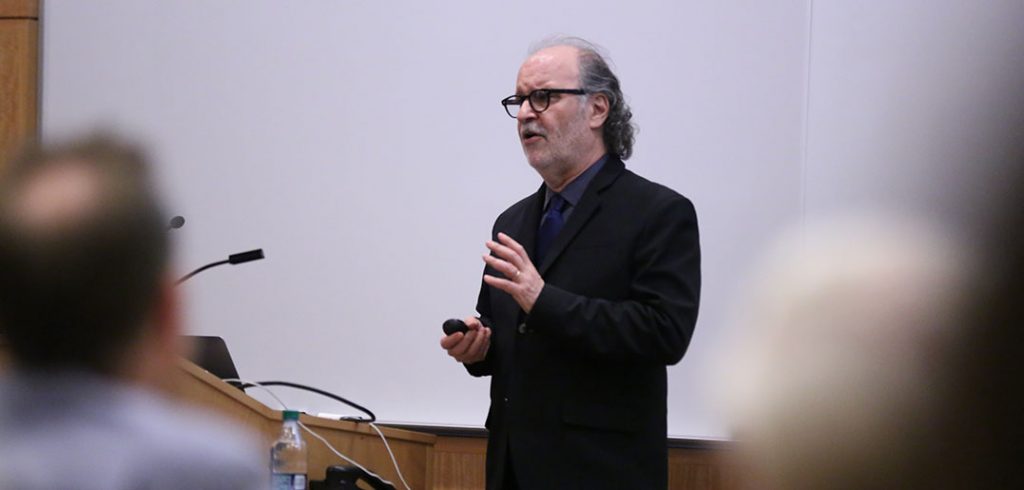Speaking at Fordham on Feb. 14, Ross Brann, the Milton R. Konvitz professor of Judeo-Islamic studies and Stephen H. Weiss Presidential Fellow at Cornell University, shared how key events in the Middle East served to accelerate religious nationalism in the Israeli-Palestinian conflict.
“Up until 1948 and 1967 [the Israeli-Palestinian conflict]was entirely a conflict about land and sovereignty,” he said.
Secular Grounds
Brann said that in the 1950s, Gamal Abdel Nasser, the second president of Egypt, used the plight of the Palestinian people as a way to convey the importance of pan-Arab politics and Arab nationalism, envisioning a secular “pan-Arab” world with Egypt at its center.
Brann said that Zionism, a Jewish nationalism movement, and the State of Israel were also established on secular grounds. He noted that a majority of texts of the Orthodox and ultra-Orthodox Jewish establishment in Eastern Europe, where Zionism originated, suggest that Jewish Orthodoxy and Judaism as a religion would be “relegated to the margins of Jewish life.”
Before 1967, he said, “secularity defined the ideologies of Zionism and Arab nationalism and the political behaviors and choices that the states abiding by these ideas acted upon in the context of the conflict, and really even beyond it.”
The Six-Day War
According to Brann, one pivotal turn toward religious nationalism resulted from Israel’s June 1967 six-day war against Egypt, Syria, and Jordan, wherein Israel ultimately gained control of the West Bank, Sinai Peninsula, East Jerusalem, and the Golan Heights.
“Pan-Arabism was discredited at every level, and every state was now on its own,” said Brann, who explained that the key questions for Egyptians and other thinkers during this period were determining what new ideology could “fill the void” and safeguard Palestinian rights and interests.
Then came the Islamic Revolution in Iran of 1978–1979. The violent uprising resulted in the fall of the monarchy of Shah Mohammed Reza Pahlavi and established the world’s first Islamic state under the theocracy of Shiite leader Ayatollah Ruhollah Khomeini.
Rise of Religious Nationalism
According to Brann, religious nationalism after the 1967 war grew dramatically in multiple guises in each religious community.
The growth was facilitated through some key Israeli and Palestine groups founded after 1967. They include a Jewish underground that developed in the West Bank in the late 1970s; the Shiite Islamic militant group Hezbollah, which was established in 1980 in Lebanon; and the Sunni-Islamic Hamas, a branch of the Muslim Brotherhood, which did not exist until 1987, Brann said. It added a “divine” aspect to the land that the factions shared, causing increased tension, he said.
“The appeal of the certainty that comes with the wedding of religious[ness]and nationalism only grows,” he said.
The fact that the Arab and Jewish populations are roughly equivalent could impact the conflict in a significant way, Brann said, especially with regard to how the opposing sides will move forward. There are approximately 6.3 million Israeli Jews on the grounds today—600,000 in Eastern Jerusalem and the West Bank—and almost 6 million Palestinians living in Israel, Jerusalem, Gaza, and the West Bank.
“This conflict, as we know from its entire history, is difficult enough when we simply view it as a political conflict between two peoples with contrary ambition in the same territory,” he said. “Since 1967, with the addition of religious nationalism and its growing strength both in the Israeli sector and the Palestinian sector, it’s gotten only more complicated.”
Organized by the University’s Department of History, the Jewish Studies program, and Middle Eastern Studies program, Brann’s talk is the first event in a series of lectures and workshops focused exclusively on the Israeli-Palestinian conflict.

